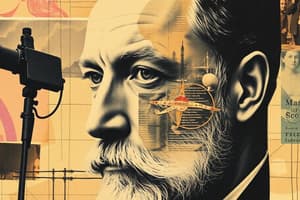Podcast
Questions and Answers
Which of the following is NOT a component of Freud's structural model of personality?
Which of the following is NOT a component of Freud's structural model of personality?
- Ego
- Superego
- Id
- Collective Unconscious (correct)
Repression, denial, and projection are examples of ego defense mechanisms.
Repression, denial, and projection are examples of ego defense mechanisms.
True (A)
In psychoanalysis, what is the purpose of 'free association'?
In psychoanalysis, what is the purpose of 'free association'?
To allow unconscious thoughts to emerge through speech.
The gradual integration of insights over time in psychoanalysis is known as ______.
The gradual integration of insights over time in psychoanalysis is known as ______.
Match the psychosexual stage with its primary focus:
Match the psychosexual stage with its primary focus:
What is the central idea behind Freud's concept of 'unconscious motivation'?
What is the central idea behind Freud's concept of 'unconscious motivation'?
Transference refers to the therapist's emotional reactions to the client.
Transference refers to the therapist's emotional reactions to the client.
What is 'resistance' in the context of psychoanalysis?
What is 'resistance' in the context of psychoanalysis?
Interpreting latent and manifest dream content is part of ______ in psychoanalysis.
Interpreting latent and manifest dream content is part of ______ in psychoanalysis.
Which of the following is a key difference between Anna Freud's Ego Psychology and Classical Psychoanalysis?
Which of the following is a key difference between Anna Freud's Ego Psychology and Classical Psychoanalysis?
In Ego Psychology, developmental lines refer to strict psychosexual stages.
In Ego Psychology, developmental lines refer to strict psychosexual stages.
According to Ego Psychology, what does 'adaptive ego functioning' refer to?
According to Ego Psychology, what does 'adaptive ego functioning' refer to?
Rationalization and sublimation are examples of ______ defense mechanisms.
Rationalization and sublimation are examples of ______ defense mechanisms.
Which concept is central to Object Relations Theory?
Which concept is central to Object Relations Theory?
According to Klein, the 'Good Enough Mother' is required to be perfect.
According to Klein, the 'Good Enough Mother' is required to be perfect.
In Object Relations Theory, what is 'splitting'?
In Object Relations Theory, what is 'splitting'?
Teddy bears are an example of ______ objects.
Teddy bears are an example of ______ objects.
What is the primary focus of Self Psychology (Heinz Kohut)?
What is the primary focus of Self Psychology (Heinz Kohut)?
'Mirroring' in Self Psychology refers to parental responsiveness that supports self-esteem.
'Mirroring' in Self Psychology refers to parental responsiveness that supports self-esteem.
What is 'idealizing transference' in Self Psychology?
What is 'idealizing transference' in Self Psychology?
Flashcards
Structural Model of Personality
Structural Model of Personality
The division of personality in psychoanalytic theory, consisting of the id, ego, and superego.
Topographical Model
Topographical Model
The mapping of the mind in psychoanalytic theory that emphasizes the conscious, preconscious, and unconscious.
Psychosexual Stages
Psychosexual Stages
Stages of development focused on erogenous zones: oral, anal, phallic, latency, and genital.
Defense Mechanisms
Defense Mechanisms
Signup and view all the flashcards
Unconscious Motivation
Unconscious Motivation
Signup and view all the flashcards
Free Association
Free Association
Signup and view all the flashcards
Transference
Transference
Signup and view all the flashcards
Countertransference
Countertransference
Signup and view all the flashcards
Resistance
Resistance
Signup and view all the flashcards
Dream Analysis
Dream Analysis
Signup and view all the flashcards
Working Through
Working Through
Signup and view all the flashcards
Adaptive Ego Functioning
Adaptive Ego Functioning
Signup and view all the flashcards
Developmental Lines
Developmental Lines
Signup and view all the flashcards
Child Psychoanalysis
Child Psychoanalysis
Signup and view all the flashcards
Resilience & Coping
Resilience & Coping
Signup and view all the flashcards
Splitting (Klein)
Splitting (Klein)
Signup and view all the flashcards
Good Enough Mother (Winnicott)
Good Enough Mother (Winnicott)
Signup and view all the flashcards
Separation-Individuation (Mahler)
Separation-Individuation (Mahler)
Signup and view all the flashcards
Self-Cohesion
Self-Cohesion
Signup and view all the flashcards
Mirroring
Mirroring
Signup and view all the flashcards
Study Notes
Sigmund Freud (Classical Psychoanalysis)
- Structural personality model involves the id, ego, and superego
- Topographical model consists of the conscious, unconscious and preconscious
- Psychosexual stages include oral, anal, phallic, latency and genital
- Defense mechanisms that exist are repression, denial, and projection
- Unconscious motivation refers to hidden desires driving behavior
- Seduction theory is the now abandoned idea that psychological distress was from girls being raped
- Repetition compulsion involves unconsciously repeating past conflicts
- Free association involves letting unconscious thoughts emerge through speech
- Transference involves projecting feelings about important figures onto the therapist
- Countertransference refers to the therapist's emotional reactions to the client
- Resistance is unconscious avoidance of distressing insights
- Dream analysis means interpreting latent and manifest dream content
- Working through involves gradual integration of insights over time
Anna Freud (Ego Psychology & Defense Mechanisms)
- Expanded defense mechanisms include rationalization, sublimation, and reaction formation
- Child psychoanalysis uses developed play therapy techniques
- Ego development involves the ego being an active force in personality, not just a mediator
- Adaptive ego functioning involves the ego adapting to the external world, not just internal conflicts
- Developmental lines consist of continuous development rather than strict psychosexual stages
- Social Environments role has emphasis on the impact of social influences
Ego Psychology (Erikson, Hartmann)
- Ego as autonomous functions beyond id mediation
- Adaptive functions include reality testing, problem-solving, impulse control
- Psychosocial development (Erikson) expands Freud's stages into lifelong growth
- Conflict-Free Ego Sphere (Hartmann) has some ego functions that are independent of conflict.
- Competence & Mastery involves humans seeking skill development and environmental mastery
- Resilience & Coping focuses on how individuals adapt to stress and trauma
Object Relations Theory (Klein, Winnicott, Fairbairn, Mahler)
- Internalized objects are mental representations of caregivers and relationships
- Splitting (Klein) involves viewing people as all good or all bad
- Good Enough Mother (Winnicott) refers to the importance of responsive but not perfect caregiving
- Separation-Individuation (Mahler) is the developmental process of forming an independent self
- Transitional Objects (Winnicott) are objects (e.g., teddy bears) that provide emotional security
- Attachment & Early Development influences of early caregiver relationships on personality (Bowlby, Ainsworth, & Main developed theories of attachment regarding, secure, insecure and disorganized)
Self Psychology (Heinz Kohut)
- Self-Cohesion refers to a stable and integrated sense of self
- Mirroring means parental responsiveness supports self-esteem
- Empathy in therapy involves the therapist acting as a self object to support development
- Idealizing Transference involves clients seeking an idealized figure in therapy
- Fragmented Self is the concept that failure to develop a cohesive self can lead to disorders
- Narcissistic Vulnerabilities explores how self-esteem injuries impact personality
Summary of Key Differences
- Freud's Psychoanalysis is focused on intrapsychic conflict, with key contributions including the Id, Ego, Superego, psychosexual stages and defense mechanisms
- Psychoanalysis is deterministic with early childhood focus
- Ego Psychology focuses on the ego's adaptive function
- Ego psychology involves defense mechanisms, child analysis and developmental lines
- More emphasis is placed on ego strength & adaptation
- Object Relations focuses on relationships and the development across lifespan and with a resilience focus
- Key contributions include internalized objects, attachment and separation-individuation
- Self Psychology focuses on self-cohesion, with key contributions including mirroring, idealizing transference and self object needs
- Early relationships shape personality more than drives, with an emphasis is on self-esteem, empathy, and narcissistic injuries
Studying That Suits You
Use AI to generate personalized quizzes and flashcards to suit your learning preferences.




